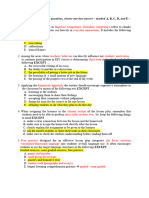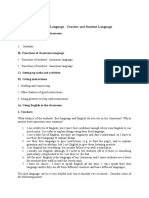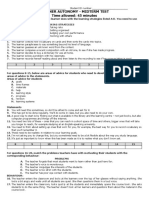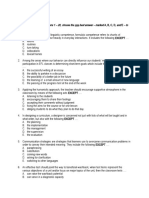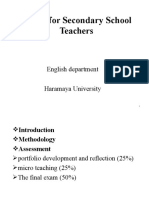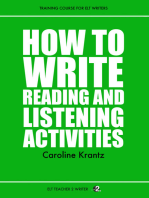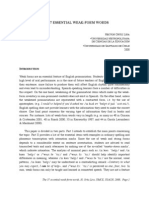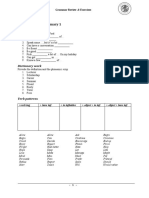Sample tasks-TKT Module 3
Sample tasks-TKT Module 3
Uploaded by
deliamaroneCopyright:
Available Formats
Sample tasks-TKT Module 3
Sample tasks-TKT Module 3
Uploaded by
deliamaroneCopyright
Available Formats
Share this document
Did you find this document useful?
Is this content inappropriate?
Copyright:
Available Formats
Sample tasks-TKT Module 3
Sample tasks-TKT Module 3
Uploaded by
deliamaroneCopyright:
Available Formats
TKT Module 3: Teacher language: Appropriacy of use –
Participant’s Worksheet 3
Task A
For questions 1–6, match what the teacher is doing with the purposes for using the students’
first language, listed A, B and C.
Mark the correct letter (A, B or C) on your answer sheet.
Purposes for using the students’ first language
A checking understanding
B explaining procedures
C motivating
The teacher is
1 asking students to show they know what to do for homework.
2 giving individual written feedback to a weak student.
3 encouraging elementary students to try new ways of learning.
4 telling a large group of teenagers the rules of a game.
5 asking students to translate the meaning of new words.
6 showing a group of beginners exactly how to use a self-access centre.
© UCLES 2009. This material may be photocopied (without alteration) and distributed for classroom use provided no charge is made. For further
information see our Terms of Use at http://www.teachers.cambridgeESOL.org/ts/legalinfo
TKT Module 3: Teacher language: Appropriacy of use – Participant’s Worksheet 3
www.teachers.cambridgeesol.org
Page 6 of 9
TKT Module 3: Teacher language: Appropriacy of use –
Participant’s Worksheet 4
Task B
For questions 1–6, match the teacher’s instructions to an elementary class with the teacher
trainer’s comments, listed A–G. Mark the correct letter (A, B or C) on your answer sheet.
There is one extra option which you do not need to use.
Teacher’s instructions
1 Compare your answers with what the others have written down. Oh, first you should get
into groups.
2 Write the essay tonight and hand it in tomorrow, please.
3 Now, we’re going to move on to the role play on page 7. Read the instructions and start
when you’re ready. OK, off you go!
4 Can anybody tell me the answer to number 1?
5 Right, could you all turn to page 72. Or is it 62? Wait a minute, I’ll just look…it’s 52. Sorry.
6 Sorry, no more time for questions. We need to move on. We’ve got a lot to get through this
morning.
Teacher trainer’s comments
A I don’t think you’ve allowed them enough time, check that they don’t have any other homework
to do.
B You need to think before you speak and decide on the order you want the class to do things
in.
C Don’t be in such a hurry to start new work – it’s more important for students to understand
what they’ve done so far.
D Check references in your lesson plan in advance, not while you’re giving the instructions.
E Try to avoid repeating yourself – it doesn’t necessarily make students understand instructions
any better.
F It’s better to nominate a particular student, rather then asking the whole class, in order to give
the weaker ones a chance.
G Always check students have understood your instructions. A demonstration of the activity is a
good idea.
© UCLES 2009. This material may be photocopied (without alteration) and distributed for classroom use provided no charge is made. For further
information see our Terms of Use at http://www.teachers.cambridgeESOL.org/ts/legalinfo
TKT Module 3: Teacher language: Appropriacy of use – Participant’s Worksheet 4
www.teachers.cambridgeesol.org
Page 7 of 9
TKT Module 3: Teacher language: Appropriacy of use –
Participant’s Worksheet 5
Task C
For questions 1–6 look at the classroom activities and the teachers’ instructions listed A, B and
C. Choose the instruction that would come first, A, B or C. Mark the correct letter (A, B or C) on
your answer sheet.
The teacher gives learners an article from a newspaper to read for the first time. The teacher
1
says:
A Discuss what you think about the opinions in the article in pairs.
B Read the article quickly and decide on a good title for it.
C Look at these 10 questions. The answers are in the text. You have fifteen minutes.
The teacher wants to teach learners some new vocabulary connected to food. The teacher
2
says:
A Look at this picture. What is this? Yes, good, biscuit.
B Listen and repeat – biscuit, all together – biscuit.
C Can you make a sentence using the word biscuit?
The teacher wants learners to practise language learnt in the lesson by doing a role play. The
3
teacher says:
A Gina and Laura, come to the front here and do your role play for the whole class.
B Look at the cards I have given you. This is some more information about the people.
C ‘A’s, you are the interviewer and ‘B’s, you are a famous person being interviewed.
The teacher wants learners to develop their oral fluency in a discussion activity. The teacher
4
says:
A Antonio, what did your group think about question number 1?
B Talk about these questions in groups. Choose someone to report back for the group.
C There are some comments you made on the board. Can you correct them?
The teacher wants learners to use a recording of a song as a listening comprehension
5
exercise in class. The teacher says:
A Read the transcript and underline the words that you don’t know.
B Listen and tell me what kind of song you think this is: happy? sad? romantic?
C While you listen to the song, fill in the gaps in the transcript.
6 The teacher wants to help learners with intonation patterns. The teacher says:
A Practise the sentences with your partner. Make sure you sound interested or bored.
B Come to the board and write your answers. I if they’re interested and B if they’re bored.
C Listen to these people talking. Do they sound interested or bored?
© UCLES 2009. This material may be photocopied (without alteration) and distributed for classroom use provided no charge is made. For further
information see our Terms of Use at http://www.teachers.cambridgeESOL.org/ts/legalinfo
TKT Module 3: Teacher language: Appropriacy of use – Participant’s Worksheet 5
www.teachers.cambridgeesol.org
Page 8 of 9
You might also like
- Lesson Plans and Activities for Teachers and Tutors of ESL for AdultsFrom EverandLesson Plans and Activities for Teachers and Tutors of ESL for AdultsRating: 4 out of 5 stars4/5 (15)
- The Boy in the Striped Pajamas - Literature Kit Gr. 7-8From EverandThe Boy in the Striped Pajamas - Literature Kit Gr. 7-8Rating: 5 out of 5 stars5/5 (2)
- Entry TestDocument8 pagesEntry Testa_perfect_circleNo ratings yet
- Cursive Writing Practice Jokes & RiddlesDocument48 pagesCursive Writing Practice Jokes & Riddleshtopg100% (10)
- TKT Module 3 Teacher Language Appropriacy of Use PDFDocument9 pagesTKT Module 3 Teacher Language Appropriacy of Use PDFRachel Maria RibeiroNo ratings yet
- Graduation Paper - Methodology-K08Document9 pagesGraduation Paper - Methodology-K08tiendanghia18101992No ratings yet
- TKT Module 1 Part 2 TestDocument5 pagesTKT Module 1 Part 2 TestLeo Corona Hernandez100% (2)
- M 3 - Test 2Document10 pagesM 3 - Test 2Step FirstNo ratings yet
- YLE Movers Reading & Writing Part 3 - Teacher's Notes: DescriptionDocument6 pagesYLE Movers Reading & Writing Part 3 - Teacher's Notes: DescriptionmuphyNo ratings yet
- TKT Module 3 Sample Paper DocumentDocument20 pagesTKT Module 3 Sample Paper DocumentAlejandro Zolis67% (3)
- Cambridge English b1 Preliminary Reading and Writing Part 5Document10 pagesCambridge English b1 Preliminary Reading and Writing Part 5Dynamic English InstituteNo ratings yet
- Georgia Education Exams TKT Module3Document16 pagesGeorgia Education Exams TKT Module3Faby SanchezNo ratings yet
- The Master 140 Hour TEFL Course: TKT Unit 5 Section 1: Classroom Language - Teacher and Student LanguageDocument7 pagesThe Master 140 Hour TEFL Course: TKT Unit 5 Section 1: Classroom Language - Teacher and Student LanguageSuzana AnđelkovićNo ratings yet
- A1 Movers 2018 Reading and Writing Part 2Document8 pagesA1 Movers 2018 Reading and Writing Part 2Phạm Minh TríNo ratings yet
- Cambridge English Movers Reading and Writing Part 3 PDFDocument7 pagesCambridge English Movers Reading and Writing Part 3 PDFAruzaAruza100% (2)
- Richards Jack C., Hull Jonathan. - New Interchange 2 English For International Communication. Student's BookDocument7 pagesRichards Jack C., Hull Jonathan. - New Interchange 2 English For International Communication. Student's BookdanoNo ratings yet
- TKT Module 3 Sample Paper With Answer KeyDocument21 pagesTKT Module 3 Sample Paper With Answer KeyKaren Lizbeth BouvierNo ratings yet
- IELTS Listening Task 5 Sentence Completion v3Document8 pagesIELTS Listening Task 5 Sentence Completion v3Muhammad Fazle Rabbi (202054005)No ratings yet
- TKT Module 3 2007Document15 pagesTKT Module 3 2007Tariq AlMozoghiNo ratings yet
- Taufik Sulaiman - Bahasa InggrisDocument8 pagesTaufik Sulaiman - Bahasa InggrisZartahum ZarNo ratings yet
- Handout 31 May HLT SessionDocument2 pagesHandout 31 May HLT SessionMarwen NamouchiNo ratings yet
- 1011 engDocument13 pages1011 engAinur IgilikNo ratings yet
- Soal PedagogikDocument9 pagesSoal PedagogikfitriaNo ratings yet
- PET Reading Part 5 - Teacher's Notes: 60 Minutes Plus HomeworkDocument11 pagesPET Reading Part 5 - Teacher's Notes: 60 Minutes Plus HomeworkAnonymous rCXJ4wIZUJNo ratings yet
- TKT Unit 5Document31 pagesTKT Unit 5Jelena Mitrovic100% (1)
- Cantuta Máster 12-11-2024 (1)Document10 pagesCantuta Máster 12-11-2024 (1)Ali BE RONo ratings yet
- Part 2. Correcting LearnersDocument7 pagesPart 2. Correcting LearnersMaksym BuchekNo ratings yet
- TasksDocument8 pagesTasksapi-302345809No ratings yet
- TKT Practice Test Module 3Document5 pagesTKT Practice Test Module 3Isabelle Gorgeu100% (1)
- ? To Improve WritingDocument5 pages? To Improve WritingReda AlsadekNo ratings yet
- SOAL DAY 09 Mr. IDP UKPPPG PILOTING - SJT - PCK BAHASA INGGRISDocument5 pagesSOAL DAY 09 Mr. IDP UKPPPG PILOTING - SJT - PCK BAHASA INGGRISAng Channel100% (4)
- Cambridge English Empower Empower C1 Reading Plus Teacher U05 WorksheetDocument2 pagesCambridge English Empower Empower C1 Reading Plus Teacher U05 WorksheetGERESNo ratings yet
- RepetMat U03 Test Podst ADocument2 pagesRepetMat U03 Test Podst Aslawomir.patronNo ratings yet
- TKT Final TestDocument9 pagesTKT Final TestJhonatan VélezNo ratings yet
- Teachers Language in The ClassroomDocument1 pageTeachers Language in The Classroomapi-427719699No ratings yet
- Pet For Schools Writing Part 3Document11 pagesPet For Schools Writing Part 3axus777No ratings yet
- Pre A1 Starters 2018 Listening Part 3 PDFDocument8 pagesPre A1 Starters 2018 Listening Part 3 PDFkou657No ratings yet
- Pre A1 Starters 2018 Listening Part 3Document8 pagesPre A1 Starters 2018 Listening Part 3Dũng HồNo ratings yet
- Pre A1 Starters 2018 Listening Part 3Document8 pagesPre A1 Starters 2018 Listening Part 3Diana OrtegaNo ratings yet
- ELT (CURR107) Final AssignmentDocument6 pagesELT (CURR107) Final Assignmentเ ค๓ ђєг๏No ratings yet
- Contoh Soal 1 Set Utn 2017Document18 pagesContoh Soal 1 Set Utn 2017anang rahmadiNo ratings yet
- KEY To FINAL TEST - Teaching MethodologyDocument4 pagesKEY To FINAL TEST - Teaching Methodologynguyen anNo ratings yet
- Learner Autonomy Midterm Test (2022)Document2 pagesLearner Autonomy Midterm Test (2022)Thu Hồng Hồ ThịNo ratings yet
- 20.8.2019 Tue 5.6.3 GerakgempurDocument1 page20.8.2019 Tue 5.6.3 GerakgempurhannaNo ratings yet
- Senior High School Daily Lesson Log Grade 11Document19 pagesSenior High School Daily Lesson Log Grade 11Jansen Ann MarieNo ratings yet
- Task Based Grammar Teaching Topic 13Document6 pagesTask Based Grammar Teaching Topic 13Daniel Garzia Aizrag100% (1)
- Directions: To Answer Questions 1 - 20, Choose The One Best Answer - Marked A, B, C, D, and E - To Each QuestionDocument16 pagesDirections: To Answer Questions 1 - 20, Choose The One Best Answer - Marked A, B, C, D, and E - To Each Questionsinyo2010No ratings yet
- Lesson Plan TraditionalDocument5 pagesLesson Plan Traditionalepol67% (3)
- Soal Latihan Uji Kompetensi PPG Prajabatan 7Document17 pagesSoal Latihan Uji Kompetensi PPG Prajabatan 7Boy SimangunsongNo ratings yet
- PGDT Clasroom Eng.Document107 pagesPGDT Clasroom Eng.Dinaol D Ayana100% (4)
- 27Document16 pages27Cho MonNo ratings yet
- Simulacro English ExamDocument5 pagesSimulacro English ExamYhasmin Lucero Escobar AlcaNo ratings yet
- LLDHDocument14 pagesLLDHDương LệNo ratings yet
- Writing B1 Unit 2Document4 pagesWriting B1 Unit 2eddydasilvaNo ratings yet
- TKT Module 3 Part 1 Functions of Teacher LanguageDocument6 pagesTKT Module 3 Part 1 Functions of Teacher LanguageALFREDO6411No ratings yet
- How To Write Reading And Listening ActivitiesFrom EverandHow To Write Reading And Listening ActivitiesRating: 5 out of 5 stars5/5 (2)
- Teaching English, How To.......:: A K-12 Supervisor's Guide to Teaching Secondary EnglishFrom EverandTeaching English, How To.......:: A K-12 Supervisor's Guide to Teaching Secondary EnglishNo ratings yet
- Student Practice Tests Booklet in Reading and Writing: Upper Elementary Grades 3 to 5 Comprehension and Writing Teacher to StudentFrom EverandStudent Practice Tests Booklet in Reading and Writing: Upper Elementary Grades 3 to 5 Comprehension and Writing Teacher to StudentNo ratings yet
- Exceptions To The LLI RuleDocument4 pagesExceptions To The LLI RuledeliamaroneNo ratings yet
- Event SentencesDocument2 pagesEvent SentencesdeliamaroneNo ratings yet
- Weak FormsDocument16 pagesWeak FormsHans JahnsenNo ratings yet
- Notes On Brazil S BookDocument11 pagesNotes On Brazil S BookdeliamaroneNo ratings yet
- Brazil S Tones in Action (Short Dialogues)Document3 pagesBrazil S Tones in Action (Short Dialogues)deliamaroneNo ratings yet
- Domesticity in Turn of The Century Literature - BR - 240226 - 150627Document5 pagesDomesticity in Turn of The Century Literature - BR - 240226 - 150627deliamaroneNo ratings yet
- A. Look at The Picture CarefullyDocument2 pagesA. Look at The Picture CarefullydeliamaroneNo ratings yet
- Subject Pronouns and Verb TO BEDocument1 pageSubject Pronouns and Verb TO BEdeliamaroneNo ratings yet
- Short Answer With CAN Short Answer With TO BE: Boy BoyDocument3 pagesShort Answer With CAN Short Answer With TO BE: Boy BoydeliamaroneNo ratings yet
- Classification of PoetryDocument2 pagesClassification of Poetrydeliamarone100% (1)
- Review 1st Year-BiginnersDocument1 pageReview 1st Year-BiginnersdeliamaroneNo ratings yet
- I. Theory of Value: What Knowledge and Skills Are Worthwhile Learning?Document8 pagesI. Theory of Value: What Knowledge and Skills Are Worthwhile Learning?deliamaroneNo ratings yet
- Present SimpleDocument2 pagesPresent SimpledeliamaroneNo ratings yet
- Resent Imple: 1. Oral: Question and AnswerDocument2 pagesResent Imple: 1. Oral: Question and AnswerdeliamaroneNo ratings yet
- Passive Voice ExercisesDocument1 pagePassive Voice ExercisesdeliamaroneNo ratings yet
- Language Summary 1Document2 pagesLanguage Summary 1deliamaroneNo ratings yet
- Pols 302 SyllabusDocument11 pagesPols 302 Syllabusapi-321050247No ratings yet
- ScriptDocument2 pagesScriptRas GillNo ratings yet
- Lesson Notes English Year 1Document12 pagesLesson Notes English Year 1Ima KhalidNo ratings yet
- Lesson Plan f2 (Group5)Document4 pagesLesson Plan f2 (Group5)shazrina100% (1)
- Caitlyn Forte - DDT LOG 2018-2Document5 pagesCaitlyn Forte - DDT LOG 2018-2Caitlyn ForteNo ratings yet
- Katherine Mansfield - Miss BrillDocument3 pagesKatherine Mansfield - Miss BrillNicoletaPetcuNo ratings yet
- Soal STMDocument12 pagesSoal STMsetio_wagiyantoNo ratings yet
- ENGL 5010: Introduction To Graduate Study-TESL: Course DescriptionDocument11 pagesENGL 5010: Introduction To Graduate Study-TESL: Course DescriptionFernando NavarroNo ratings yet
- Expanded Abstract Action ResearchDocument3 pagesExpanded Abstract Action ResearchHerman M. LagonNo ratings yet
- Guide For Ict MentorsDocument53 pagesGuide For Ict MentorsJonathan QuintanoNo ratings yet
- 2009 Spring - Star MagazineDocument12 pages2009 Spring - Star MagazineUNT IELINo ratings yet
- Giao An Tieng Anh 11 Hay Nhin La Muon TaiDocument315 pagesGiao An Tieng Anh 11 Hay Nhin La Muon TaiLe Hoang LinhNo ratings yet
- Earl Shorris - The Restless PoorDocument14 pagesEarl Shorris - The Restless PoorJarmitage123No ratings yet
- Flipping The ClassroomDocument2 pagesFlipping The Classroomapi-321629846No ratings yet
- Social Cognitive TheoryDocument19 pagesSocial Cognitive TheoryAnnisa Delya100% (1)
- Teacher's BookDocument289 pagesTeacher's Booktuky82No ratings yet
- Test Level: A2 Name: Part 1: ReadingDocument3 pagesTest Level: A2 Name: Part 1: ReadingMariluz Rocha BustamanteNo ratings yet
- Iran Tennis 10s' Workshop - 2011 (Summary)Document10 pagesIran Tennis 10s' Workshop - 2011 (Summary)james_newman5280No ratings yet
- An Apple For The Teacher - Beverly Hills Weekly, Issue #658Document4 pagesAn Apple For The Teacher - Beverly Hills Weekly, Issue #658BeverlyHillsWeeklyNo ratings yet
- Thehomeschoolmagazine201301 DLDocument120 pagesThehomeschoolmagazine201301 DLsstdiana100% (1)
- Maths Through StorytellingDocument3 pagesMaths Through Storytellingapi-336022570No ratings yet
- Grade 6 DLL Mapeh q2 Week 1Document4 pagesGrade 6 DLL Mapeh q2 Week 1Vanj Canoy100% (3)
- Sampling Methods Biased Samples Lesson PlanDocument10 pagesSampling Methods Biased Samples Lesson Planapi-314719374No ratings yet
- SRC Tuburan NhsDocument15 pagesSRC Tuburan NhsJordenn Alexandra NobleNo ratings yet
- Eng 7 (0305)Document2 pagesEng 7 (0305)Joan Cala-or ValonesNo ratings yet
- Asst. Vice Chancellor For Student Success PresentationDocument18 pagesAsst. Vice Chancellor For Student Success PresentationjenNo ratings yet
- Course Code EDU 712 Professionalism in TeachingDocument73 pagesCourse Code EDU 712 Professionalism in TeachingolalekanNo ratings yet
- Elt 271 Chapter 7Document5 pagesElt 271 Chapter 7Saida Nigmetova100% (1)























